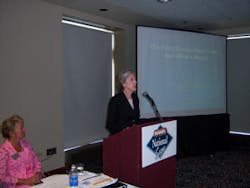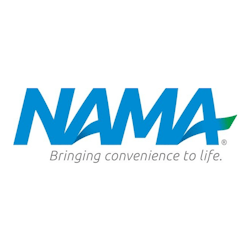Keeping up with all of the legislative, regulatory and public relations issues affecting the automatic merchandising industry has become very cumbersome as a result of the change in federal administration. Fortunately, the National Automatic Merchandising Association (NAMA) has a team of government affairs and public relations professionals in place to address these issues, as was evidenced during the government affairs symposium on the first day of the National Expo at Navy Pier in Chicago.
Jackie Clark, NAMA director of public relations, hosted a panel on what’s ahead for food and the environment. The first panelist to speak was Sylvia Rowe, president of SR Strategy, a food industry consultant, who talked about the increasing volatility of food as a public issue on account of rising obesity.
“All nutrition issues today are seen through the eyes of obesity.” Rowe said.
Government and community organizations are more interested in seeing more nutrition restrictions because they believe that education alone has not resulted in better eating habits, Rowe said.
One reason these parties are more interested in more regulation is they recognize that obesity has a major impact on health care costs.
“There’s a new sheriff in town; that’s regulation,” Rowe said.
The U.S. Department of Health and Human Services (HHS) under the new administration is staffed with people who are more aggressive in their views about regulation, Rowe said. These include Kathleen Sebelius, Secretary of HHS; Margaret Hamburg, M.D., the Food and Drug Administration’s Commissioner of Food and Drugs; Thomas Freiden, M.D., director of the Centers for Disease Control and Prevention; Kathleen Merrigan, Deputy Secretary of Agriculture; and Jerold R. Mande, M.P.H., Deputy Undersecretary for Food Safety at the U.S. Department of Agriculture.
Rowe also said First Lady Michelle Obama is showing interest in obesity. “Most First Ladies have an issue,” Rowe said. She said many think Michelle Obama will make child obesity her issue.
Obesity, many believe, is costing the U.S. more than $100 billion a year in health care costs. “In essence, ending obesity would save our health system 50 percent more than curing cancer,” Rowe said.
Increasingly, experts are coming to the conclusion that menu labeling on food packages will save lives.
One of the negative aspects from the food industry’s perspective is public perception that the industry is keeping secrets from the public, Rowe said.
New public thought leaders include Michael Pollan, author of “In Defense of Food: An Eater’s Manifesto;” Michael Jacobson, executive director for the Center for Science in the Public Interest; Kelly Brownell, Ph.D., director of the Rudd Center for Food Policy and Obesity at Yale University; Marion Nestle, Ph.D., the Paulette Goddard Professor of Nutrition, Food Studies, and Public Health at New York University; and David Kessler, M.D., former Commissioner of the United States Food and Drug Administration.
“These people know how to work the system,” Rowe said. “They know how to work the media.”
The most relevant public report that directly affects vending, according to Rowe, is the one the Institute of Medicine (IOM) released earlier this year that recommends all caffeinated and sweetened beverages be pulled from schools, including sports drinks. Only unflavored, non-carbonated water and 100 percent fruit juices with no sugar are acceptable.
School administrators are also encouraged in the report to minimize the advertising on vending machines to students, Rowe said.
“National nutrition standards will apply in all aspects of school feeding,” she said.
Another key report she cited was the American Heart Association recommendation that provides specific levels and limits on the consumption of added sugars.
Rowe commended NAMA for responding to these public concerns with its “Balanced for Life” and “Fit Pick” initiatives. She said that NAMA’s work mustn’t stop here; NAMA must continue to be proactive.
Rowe commended NAMA for meeting this past year with the Center for Science in the Public Interest.
Clark then addressed the gathering by reviewing the Fit Pick program. She said studies have shown that obese employees cost U.S. businesses 11 times more than healthy employees. This is why about 40 percent of U.S. businesses currently offer some type of wellness program, according to Cigna, the health insurer.
“Health and wellness is here to stay and it’s not going anywhere,” Clark said.
Clark reviewed the various point-of-sale materials that can educate consumers about specific health and wellness products.
The options include two distinct nutrition standards:
- 35-10-35 Standard –
This is the most widespread nutritional guideline, and calls for products that are less than 35 percent fat, less than 10 percent saturated fat and less than 35percent total weight in sugar. Nuts and seeds are excluded.
- The Alliance for a Healthier Generation Standard – This standard begins with the 35-10-35 guidelines mentioned above, but also require a cap of 230 milligrams of sodium and for calorie caps of 180 for products sold in middle schools and 200 for products sold in high schools.
Vending operators can order stickers to be placed on the tray identifying those products that meet the standard, stickers that can be placed on the product identifying that they meet the standard, machine clings that explain the Fit Pick standard, round stickers and coin slot stickers that also explain the specifics of the Fit Pick standard.
Clark noted that the program has made vending operators heroes at some accounts. In many cases, the human resource managers do not have the materials on hand.
Another benefit of the program is its flexibility, Clark said. “With this program, it is up to you to decide what to do at your account,” she said.
Clark said Clark County in Washington State adopted Fit Pick nutritional standards as its official nutrition standards. In addition, other public and private entities have done likewise.
Clark said the 35-10-35 Institute of Medicine standard fits most guidelines. She noted that the Fit Pick list is continually updated. “We’re very strict about what goes on the list,” she said.
During the question and answer session, one operator asked if there could be a national nutrition standard for vending. Clark agreed this would be a welcome development.
During the question and answer period, one attendee asked why there has been an increase in recalled foods. Rowe gave these reasons:
- Better detection.
- An increase in imported food, resulting in more media attention on foreign recalls.






